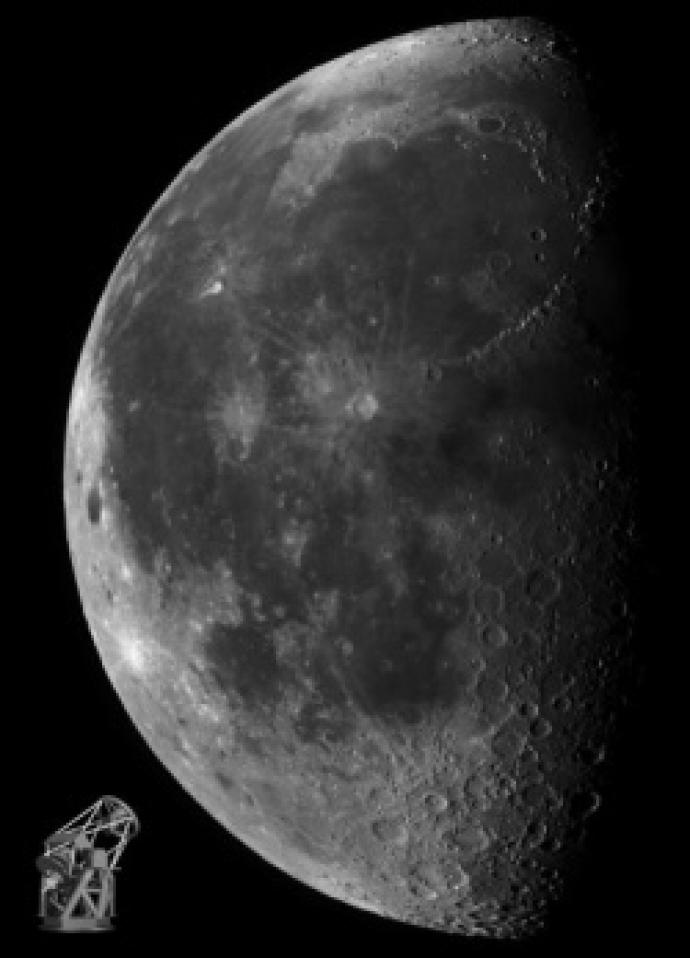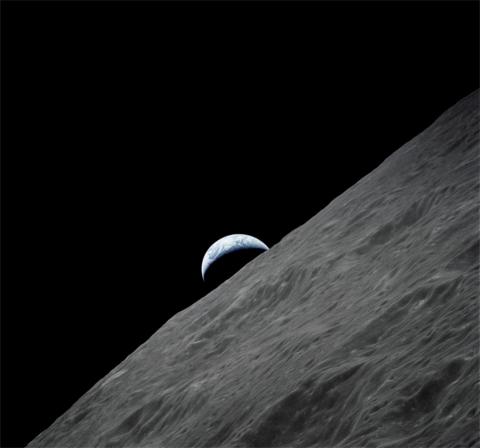The Moon is the largest and brightest object we see in the night sky.
The Earth only has one moon. There are over 200 moons in our Solar System. A moon is a natural satellite of a planet, meaning it orbits a planet and was not made by humans.
Have you ever wondered if the Moon has a name?
We usually just call it 'the Moon' but scientists sometimes call it 'Luna'. The word 'lunar' means 'relating to the Moon'.
The Earth's Moon is the 5th largest moon in the Solar System. It is 3,474 km from one side to the other. This means you could fit about 4 Moons side by side across the Earth. Gravity is weaker on the Moon because the Moon is less massive than the Earth.
Have you noticed the Moon is brighter some nights than others? It also looks like the Moon changes shape. We call these changes the phases of the Moon. This happens because the Moon orbits the Earth.
The Moon also causes the Earth's tides. Tides are the rise and fall in sea levels each day.

- Exploring the Moon
The Moon the only natural object beyond Earth that humans have visited. In 1969, the astronaut Neil Armstrong became the first person on the Moon. He travelled to the Moon as part of the Apollo 11 mission. 12 astronauts, including Neil, walked on the Moon during the Apollo missions.
Test your knowledge of Moon exploration with our Apollo Missions quiz.
The Earth has an atmosphere. We call it air. The Moon has a very thin atmosphere. It does not contain enough oxygen for people to breathe. The temperature on the Moon can be as low as -170 °C at night! But in the daytime it can rise to 120 °C. This is why Apollo astronauts needed spacesuits for protection!
The Moon is the fifth largest moon in the entire Solar System. It is 3,474 km from one side to the other (its diameter). This is about a quarter of the diameter of the Earth. This means 4 Moons would fit side by side across the Earth. The distance from the Earth to the Moon is 384,400 km. You could fit 30 planet Earth's between us and the Moon!
The gravity on the Moon is weaker than on the Earth. It is about 1/6th as strong as Earth's gravity. This is because the Moon has a smaller mass than the Earth.
- Features of the Moon
We always see the same face of the Moon from Earth. The only way to see the far side of the Moon to send a spacecraft. This is because the Moon orbits the Earth once in the same time it rotates on its axis once. We call this 'synchronous rotation'.
At any moment we observe half of the Moon from Earth. But, over a lunar month, we see more than half of the Moon's surface - about 59%. This is because of something called 'libration'. Libration occurs because the Moon's orbit is not a perfect circle.
Look carefully at the Moon's surface. You will see round craters all over its surface. The impacts of meteorites over millions of years made these craters. You should also see large dark, smooth areas. These are Maria (the Latin word for Seas). They have this name because long ago, astronomers thought they were old oceans. We now know they are solid lava. The lava is leftover from eruptions when the Moon was younger and hotter inside. The bright, light coloured highlands of the Moon contain mountains. Mountains on the Moon are the remains of high crater rims made during impacts by massive asteroids.
Beneath its surface, the Moon has a core, mantle, and crust. The Moon's dense metal core is much smaller than the Earth's core. The Moon's mantle tells us the Moon once contained a huge ocean of melted rock. We call this melted rock, magma. As the magma cooled, crystals formed within it. Heavier crystals sank down to the bottom of the magma ocean. Lighter crystals floated to the surface to form the Moon’s crust.
- How did the Moon form?
Scientists think the Moon formed when a planet the size of Mars collided with the Earth. This happened over 4,000 million years ago. There is lots of evidence for this theory, including in Moon rocks collected by the Apollo astronauts. The huge impact created a cloud of debris around the Earth. This collected together to form the Moon.
- The Moon's Orbit
An orbit is the path an object takes in space around another. The Moon makes one complete orbit of the Earth every 27.3 days. It travels around the Earth at about 4,000 kilometres an hour.
We see the Moon because it reflects the Sun's light. We only see the part of the Moon that is lit up by the Sun. The other part remains dark. The Moon receives the Sun's light from different angles as it orbits the Earth. This makes it look like the Moon is changing shape. We call these changes the phases of the Moon.
The time is takes to go from one full moon to the next, is called a lunar month. One lunar month is about 29.5 days. Have you noticed this is slightly longer than the time it takes to orbit the Earth? This is because the Earth is moving around the Sun. The Moon has to travel a bit further to get back to the same position.
The Moon is "tidally locked" into position with the Earth. One side always faces the Earth, and the other side always faces away. This is because it takes the same amount of time to spin on its axis once as it does to orbit the Earth once. The gravity between the Earth and the Moon caused this special case of tidal locking (called synchronous rotation).
Image CreditThis work by Apollo 17; NASA is licensed under Creative Commons Zero v1.0 Universal
CreditThis work by Apollo 17; NASA is licensed under Creative Commons Zero v1.0 UniversalEarth from the Moon - Lunar Libration
The Moon is locked with the Earth, which means that we always see the same side of the Moon. You would think that this meant that we could only see 50% of the Moon's surface, but we can see slightly more from Earth.
We say that the Moon has a libration. Over a lunar month, the Moon wobbles slightly in the night sky. The wobble is most obvious if you take a picture every night and then stitch them together into a video.
It moves both up and down and side to side. The movement up and down (in latitude) is due to the tilt of the Moon's axis. Just like the Earth is tilted by over 20 degrees on its axis with the Sun, giving us seasons, the Moon's axis is also tipped by about 5 degrees compared to the Earth. This tilt means that at some times in the month, we can see past the north pole of the Moon, then later in the month, past the south pole.
Two things cause the movement from side to side. Firstly, the Moon orbits the Earth in an oval or ellipse, not a circle. An oval orbit means the distance between the Earth and the Moon changes during its orbit. When the Moon is closer to the Earth, it moves faster; when it is further away, it moves slower. Because of the tilt of the Moon's axis, this speed change looks like a slight movement from side to side in the east-west direction.
Secondly, the Earth is rotating on its axis. So we see the Moon rise and set, just like the Sun. From our view point, on a spinning Earth, the Moon appears to wobble from side-to-side. It moves west first, then east.
All these effects combine and mean that rather than simply seeing 50% of the surface of the Moon, we can see 59% over the course of the lunar month!
Video fileCreditThis work by The Schools' Observatory is licensed under All rights reserved- Moon phases

